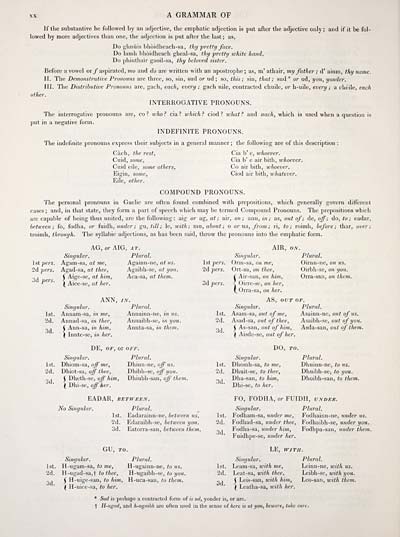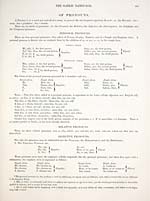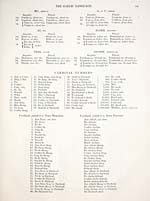Download files
Complete book:
Individual page:
Thumbnail gallery: Grid view | List view

A GRAMMAR OF
If the substantive be followed by an adjective, the emphatic adjection is put after the adjective only; and if it be fol-
lowed by more adjectives than one, the adjection is put after the last; as.
Do ghnùis bhòidheach-sa, thy ■pretty face.
Do lanih bhòidheach gheal-sa, thy pretty white hand.
Do phiuthair gaoil-sa, thy beloved sister.
Before a vowel or /aspirated, mo and do are written with an apostrophe ; as, m' athair, my father ; d' ainm, thy name.
II. The Demonstrative Pronouns are three, so, sin, sud or ud ; so, this; sin, that; sud* or ud, yon, yonder.
III. The Distributive Pronouns are, gach, each, every ; gach uile, contracted chuile, or h-uile, every ; a cheile, each
other.
INTERROGATIVE PRONOUN.S.
The interrogative pronouns are, co ? who? cia? which? ciod? what? and nach, which is used vphen a question is
put in a negative form.
INDEFINITE PRONOUN.S.
The indefinite pronouns express their subjects in a general manner ; the following are of this description :
each, the rest, CAa. b' e, whoever.
Cuid, some, Cia b' e air bith, whoever.
Cuid eile, some others, Co air bith, whoever.
Elgin, some, Ciod air bith, whatever.
Eile, other.
COMPOUND PRONOUNS.
The personal pronouns in Gaelic are often found combined with prepositions, which generally govern different
cases ; and, in that state, they form a part of speech which may be termed Compound Pronouns. The prepositions which
are capable of being thus united, are the following : aig or ag, at ; air, on ; ann, in ; as, out of; de, off; do, to ; eadar,
between; fo, fodha, or fuidh, ««de/- ; gu,till; le, with; mu, about ; o or ua., from ; ri, to; roimh, before; thar, over;
troimh, throuyh. The syllabic adjections, as has been said, throw the pronouns into the emphatic form.
AG, or AIG, AT.
Singular.
1st pers. Agam-sa, at me,
2d pers. Agad-sa, at thee,
j Aige-se, at him.
3d pers.
1st.
2d.
^ Aice-se, at her.
Plural.
Againn-ne, at us.
Agaibh-se, at you.
Aca-sa, at them.
ANN, /iv.
3d.
1st.
2d.
3d.
Singidar.
Annam-sa, in me,
Annad-sa, in thee,
i Ann-sa, in him,
\ Innte-se, in her.
Plural.
Annainn-ne, in us.
Annaibh-se, in you.
Annta-sa, in them.
DE, OF, or OFF.
AS, OUT OF.
Singular. Plural.
1st. Asam-sa, out of me, Asainn-nc, out of us.
2d. Asad-sa, 0(t< q/ </iee, Asaibh-se, o«< o/j/om.
„1 ^ A%-%M\, out of him, Asda-san, o«i o/" iAem.
( Aisde-se, out of her.
DO, TO.
Singular.
Dhiom-sa, off me,
Dhiot-sa, off thee,
^ Dheth-se, off him,
( Dhi-se, off her.
Plural.
Dhinn-ne, off us.
Dhibh-se, off you.
Dhiubh-san, off them.
EADAR, BETWEEN.
No Singular. Plural.
1 St. Eadarainn-ne, between us.
2d. Edaraibh-se, between you.
3d. Eatorra-san, between them.
GU, TO.
Singular. Plural.
1st. H-ugam-sa, to me, H-ugainn-ne, to us.
2d. H-ugad-sa,t to thee, H-ugaibh-se, to you.
„ , t H-uige-san, to him, H-uca-san, to them.
3d. ■' IT • 1 I
( H-uice-sa, to her.
1st.
2d.
3d.
1st.
2d.
3d.
FO, FODHA, or FUIDH, under.
Singular. Plural.
Fodham-sa, under me, Fodhainn-ne, under us.
Fodhad-sa, under thee, Fodhaibh-se, under you.
Fodha-sa, under him, Fodhpa-san, under them.
Fuidhpe-se, under her.
LE, WITH.
Singular.
Leam-sa, with me,
Leat-sa, with thee,
( Leis-san, with him,
\ Leatha-sa, with her.
Plural.
Leinn-ne, with us.
Leibh-se, with you.
Leo-san, with them.
* Sud is perhaps a contracled form of is ud, yonder is, or are.
■\ H-ugad, and h-vgaib/t are often used in the sense of here is ut you, beware, take care.
If the substantive be followed by an adjective, the emphatic adjection is put after the adjective only; and if it be fol-
lowed by more adjectives than one, the adjection is put after the last; as.
Do ghnùis bhòidheach-sa, thy ■pretty face.
Do lanih bhòidheach gheal-sa, thy pretty white hand.
Do phiuthair gaoil-sa, thy beloved sister.
Before a vowel or /aspirated, mo and do are written with an apostrophe ; as, m' athair, my father ; d' ainm, thy name.
II. The Demonstrative Pronouns are three, so, sin, sud or ud ; so, this; sin, that; sud* or ud, yon, yonder.
III. The Distributive Pronouns are, gach, each, every ; gach uile, contracted chuile, or h-uile, every ; a cheile, each
other.
INTERROGATIVE PRONOUN.S.
The interrogative pronouns are, co ? who? cia? which? ciod? what? and nach, which is used vphen a question is
put in a negative form.
INDEFINITE PRONOUN.S.
The indefinite pronouns express their subjects in a general manner ; the following are of this description :
each, the rest, CAa. b' e, whoever.
Cuid, some, Cia b' e air bith, whoever.
Cuid eile, some others, Co air bith, whoever.
Elgin, some, Ciod air bith, whatever.
Eile, other.
COMPOUND PRONOUNS.
The personal pronouns in Gaelic are often found combined with prepositions, which generally govern different
cases ; and, in that state, they form a part of speech which may be termed Compound Pronouns. The prepositions which
are capable of being thus united, are the following : aig or ag, at ; air, on ; ann, in ; as, out of; de, off; do, to ; eadar,
between; fo, fodha, or fuidh, ««de/- ; gu,till; le, with; mu, about ; o or ua., from ; ri, to; roimh, before; thar, over;
troimh, throuyh. The syllabic adjections, as has been said, throw the pronouns into the emphatic form.
AG, or AIG, AT.
Singular.
1st pers. Agam-sa, at me,
2d pers. Agad-sa, at thee,
j Aige-se, at him.
3d pers.
1st.
2d.
^ Aice-se, at her.
Plural.
Againn-ne, at us.
Agaibh-se, at you.
Aca-sa, at them.
ANN, /iv.
3d.
1st.
2d.
3d.
Singidar.
Annam-sa, in me,
Annad-sa, in thee,
i Ann-sa, in him,
\ Innte-se, in her.
Plural.
Annainn-ne, in us.
Annaibh-se, in you.
Annta-sa, in them.
DE, OF, or OFF.
AS, OUT OF.
Singular. Plural.
1st. Asam-sa, out of me, Asainn-nc, out of us.
2d. Asad-sa, 0(t< q/ </iee, Asaibh-se, o«< o/j/om.
„1 ^ A%-%M\, out of him, Asda-san, o«i o/" iAem.
( Aisde-se, out of her.
DO, TO.
Singular.
Dhiom-sa, off me,
Dhiot-sa, off thee,
^ Dheth-se, off him,
( Dhi-se, off her.
Plural.
Dhinn-ne, off us.
Dhibh-se, off you.
Dhiubh-san, off them.
EADAR, BETWEEN.
No Singular. Plural.
1 St. Eadarainn-ne, between us.
2d. Edaraibh-se, between you.
3d. Eatorra-san, between them.
GU, TO.
Singular. Plural.
1st. H-ugam-sa, to me, H-ugainn-ne, to us.
2d. H-ugad-sa,t to thee, H-ugaibh-se, to you.
„ , t H-uige-san, to him, H-uca-san, to them.
3d. ■' IT • 1 I
( H-uice-sa, to her.
1st.
2d.
3d.
1st.
2d.
3d.
FO, FODHA, or FUIDH, under.
Singular. Plural.
Fodham-sa, under me, Fodhainn-ne, under us.
Fodhad-sa, under thee, Fodhaibh-se, under you.
Fodha-sa, under him, Fodhpa-san, under them.
Fuidhpe-se, under her.
LE, WITH.
Singular.
Leam-sa, with me,
Leat-sa, with thee,
( Leis-san, with him,
\ Leatha-sa, with her.
Plural.
Leinn-ne, with us.
Leibh-se, with you.
Leo-san, with them.
* Sud is perhaps a contracled form of is ud, yonder is, or are.
■\ H-ugad, and h-vgaib/t are often used in the sense of here is ut you, beware, take care.
Set display mode to: Large image | Transcription
Images and transcriptions on this page, including medium image downloads, may be used under the Creative Commons Attribution 4.0 International Licence unless otherwise stated. ![]()
| Early Gaelic Book Collections > Blair Collection > Gaelic dictionary, in two parts > (42) |
|---|
| Permanent URL | https://digital.nls.uk/79284653 |
|---|
| Description | A selection of books from a collection of more than 500 titles, mostly on religious and literary topics. Also includes some material dealing with other Celtic languages and societies. Collection created towards the end of the 19th century by Lady Evelyn Stewart Murray. |
|---|
| Description | Selected items from five 'Special and Named Printed Collections'. Includes books in Gaelic and other Celtic languages, works about the Gaels, their languages, literature, culture and history. |
|---|

